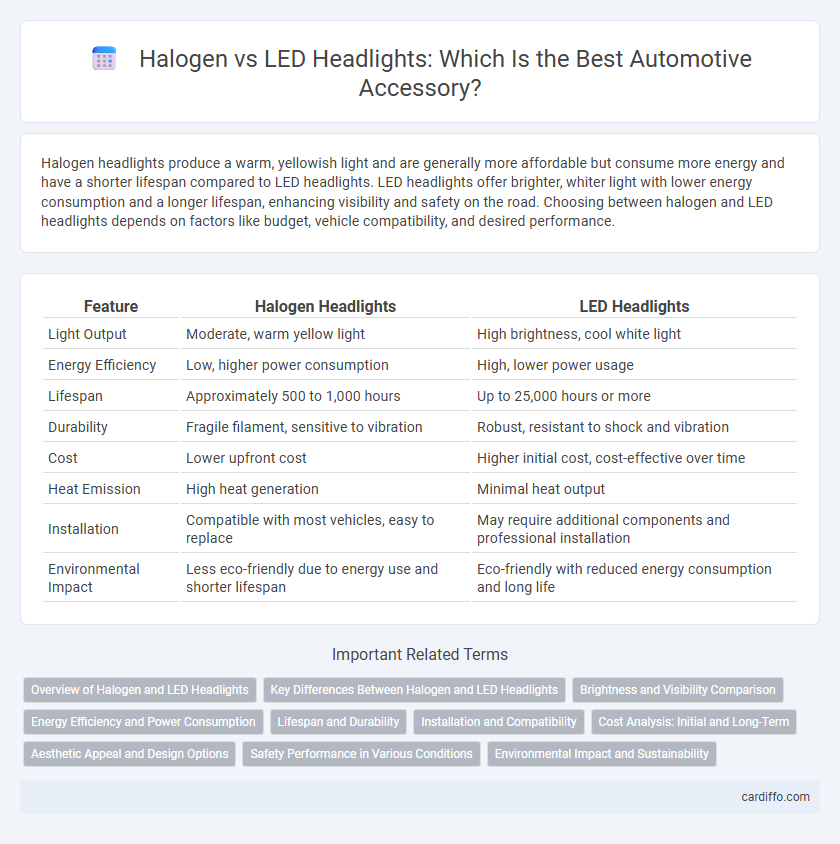Halogen headlights produce a warm, yellowish light and are generally more affordable but consume more energy and have a shorter lifespan compared to LED headlights. LED headlights offer brighter, whiter light with lower energy consumption and a longer lifespan, enhancing visibility and safety on the road. Choosing between halogen and LED headlights depends on factors like budget, vehicle compatibility, and desired performance.
Table of Comparison
| Feature | Halogen Headlights | LED Headlights |
|---|---|---|
| Light Output | Moderate, warm yellow light | High brightness, cool white light |
| Energy Efficiency | Low, higher power consumption | High, lower power usage |
| Lifespan | Approximately 500 to 1,000 hours | Up to 25,000 hours or more |
| Durability | Fragile filament, sensitive to vibration | Robust, resistant to shock and vibration |
| Cost | Lower upfront cost | Higher initial cost, cost-effective over time |
| Heat Emission | High heat generation | Minimal heat output |
| Installation | Compatible with most vehicles, easy to replace | May require additional components and professional installation |
| Environmental Impact | Less eco-friendly due to energy use and shorter lifespan | Eco-friendly with reduced energy consumption and long life |
Overview of Halogen and LED Headlights
Halogen headlights use tungsten filaments heated by electrical current to produce light, emitting a warm, yellowish glow with moderate brightness and cost-effectiveness. LED headlights consist of semiconductor diodes that emit light when electricity passes through, resulting in higher energy efficiency, longer lifespan, and brighter, whiter illumination compared to halogen bulbs. Both types serve as essential automotive lighting accessories, but LED headlights are increasingly preferred for their durability and enhanced visibility.
Key Differences Between Halogen and LED Headlights
Halogen headlights use tungsten filaments heated to produce light, offering a warm yellowish glow with moderate brightness and shorter lifespan, typically around 500 to 1,000 hours. LED headlights utilize semiconductor diodes that emit bright, white light with higher energy efficiency, longer lifespan of up to 30,000 hours, and faster illumination response times. Key differences include LED headlights providing improved visibility, reduced power consumption, and increased durability compared to traditional halogen bulbs.
Brightness and Visibility Comparison
Halogen headlights typically emit around 1,000 to 1,500 lumens, offering moderate brightness and visibility for standard driving conditions. LED headlights produce significantly higher brightness levels, ranging from 3,000 to 4,000 lumens, resulting in enhanced visibility, longer beam distance, and improved clarity in low-light environments. The superior light output and more focused beam pattern of LEDs contribute to safer nighttime driving and better reaction times on the road.
Energy Efficiency and Power Consumption
Halogen headlights consume significantly more power than LED headlights, which operate at lower wattage while providing brighter and more focused illumination. LED headlights offer superior energy efficiency by converting a higher percentage of electrical energy into light, reducing battery drain and extending vehicle runtime. This efficiency results in lower power consumption, enhancing overall vehicle fuel economy and decreasing environmental impact.
Lifespan and Durability
Halogen headlights typically last around 500 to 1,000 hours, making them less durable compared to LED headlights, which can endure up to 30,000 to 50,000 hours of use. LED headlights feature solid-state components that resist shock and vibration, enhancing their overall durability in various driving conditions. This significant difference in lifespan and robustness positions LED headlights as a more reliable and long-term lighting solution for vehicles.
Installation and Compatibility
Halogen headlights feature a simpler installation process with standard connectors compatible with most vehicle models, making them a straightforward replacement option. LED headlights often require additional components such as drivers or resistors for proper function and may need housing adjustments to fit certain headlight assemblies. Compatibility varies significantly, with halogen bulbs fitting a wide range of vehicles, while LED upgrades sometimes demand specific adapters or compatible electronic systems to ensure optimal performance and avoid electrical issues.
Cost Analysis: Initial and Long-Term
Halogen headlights generally have a lower initial cost, making them a budget-friendly option for vehicle owners. LED headlights, while more expensive upfront, offer significant energy efficiency and longer lifespan, reducing replacement frequency and maintenance costs over time. Long-term savings with LED technology often outweigh the higher initial investment through improved durability and lower power consumption.
Aesthetic Appeal and Design Options
Halogen headlights offer a classic, warm glow that complements traditional vehicle designs, while LED headlights provide a modern, crisp white light enhancing contemporary aesthetics. LED technology allows for slimmer, more versatile headlight shapes, enabling manufacturers to experiment with intricate and unique designs not possible with halogen bulbs. The energy efficiency of LEDs also supports advanced features like adaptive lighting, contributing to both functional and visual appeal in automotive accessories.
Safety Performance in Various Conditions
Halogen headlights produce a warm, yellowish light that offers adequate illumination but tends to scatter more, reducing visibility in adverse weather like fog or heavy rain. LED headlights emit a brighter, whiter light with a more focused beam pattern, enhancing road visibility and reaction times, especially in low-light and challenging conditions. Studies show LED headlights improve pedestrian detection and overall driving safety due to their higher luminous efficacy and longer lifespan compared to halogen bulbs.
Environmental Impact and Sustainability
Halogen headlights consume more energy and have a shorter lifespan, resulting in increased environmental waste and higher carbon emissions compared to LED headlights. LED headlights offer greater energy efficiency, longer durability, and reduced mercury content, contributing to lower environmental impact and enhanced sustainability. Choosing LED technology supports eco-friendly automotive practices by minimizing resource consumption and promoting recycling efforts.
Halogen headlights vs LED headlights Infographic

 cardiffo.com
cardiffo.com